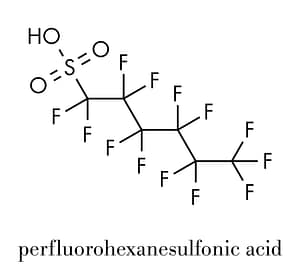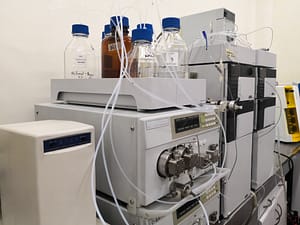Forever Chemicals are here to stay unless you actively upgrade your water treatment and finally get rid of PFAS.
Now, I get that’s easier said than done, so let’s look at it in a bit more detail.
This is one of the sections of my deep dive into water and wastewater treatment!
Key Learnings:
- PFAS can be found in a wide range of consumer products, such as nonstick cookware, stain-resistant fabrics, and fire-fighting foams. They have been linked to a number of negative health outcomes, including cancer, immune system disorders, and developmental issues in infants and children.
- Water Treatments can eliminate some or more of these PFAS through traditional approaches (granular activated carbon, reverse osmosis, advanced oxidation processes) or new and innovative ones (supercritical water oxidation, coated ultra- or nanofiltration membranes…)
- There may be an additional path beyond PFAS treatments: separating them from water and, instead of getting rid of them, recycling them back into the economy.
Table of contents
What are PFAS?
PFAS (per- and polyfluoroalkyl substances) are a group of man-made chemicals that are used in a variety of consumer products, including non-stick cookware, stain-resistant fabrics, and fire-fighting foams.

PFAS are highly resistant to breakdown and can remain in the environment for long periods of time. They have been linked to a variety of adverse health effects, including cancer, immune system disorders, and developmental problems in infants and children. Due to their potential health and environmental impacts, there has been growing concern about PFAS contamination in water and other environmental media.
When did PFAS start being used?
PFAS have been in use since the 1940s, when they were first developed for use in non-stick coatings and other industrial applications. Since then, their use has expanded to a wide range of consumer products, including food packaging, stain-resistant fabrics, and fire-fighting foams. Despite their widespread use, the potential health and environmental impacts of PFAS have only recently come to light, and there has been growing concern about PFAS contamination in water and other environmental media.
When did PFAS become an issue?
It was not until the 1990s that studies began to emerge linking PFAS exposure to a variety of adverse health effects, including cancer, immune system disorders, and developmental problems in infants and children.
As more research has been conducted on PFAS, the evidence of their potential harm has continued to grow. In response to this concern, many governments and regulatory agencies have begun to take action to address the issue of PFAS contamination and reduce exposure to these chemicals.

Why are PFAS in Water?
PFAS can enter water through a variety of sources, including industrial discharges, landfills, and agricultural runoff.
PFAS are used in a wide range of consumer products, including non-stick cookware, stain-resistant fabrics, and fire-fighting foams, and when these products are used and disposed of, they can release PFAS into the environment. Once in the environment, PFAS can leach into groundwater and surface water, contaminating drinking water sources and potentially exposing people and wildlife to these chemicals.
In addition to these sources of contamination, PFAS can also be present in water as a result of the release of PFAS-containing fire-fighting foams during training exercises or fire-fighting operations.
Does purified water have PFAS?
Short answer: Yes. Longer answer: that’s where we leave black and white to enter the realm of shades of gray. There will be PFAS but depending on the source water, the treatment train used and a wide variety of parameters, there will be more or less.
Some water treatment methods, such as granular activated carbon filtration and reverse osmosis, are pretty effective at removing PFAS from water. However, other treatment methods, such as chlorination and ultraviolet disinfection, may not remove PFAS and could potentially even break down PFAS molecules into more harmful byproducts.
Is there PFAS in Tap Water?
Most probably: yes! For reference, it is currently raining PFAS in Antarctica. So, forever chemicals are in any source of water today.

Now that isn’t necessarily a terrible thing; it’s all a matter of concentration and nature of the actual PFAS present in water.
Do you find PFAS in Bottled Water?
Short answer: yes! (again)
And probably even more than in Tap Water because it’s a given that PFAS are to be found in any water source. But on top of it, bottled water is often not processed, so there are fewer chances that a water treatment has broken some of it down or lightened the burden.
Why is PFAS a problem in our Water?
In short: because they have been linked to a variety of adverse health effects, including cancer, immune system disorders, and developmental problems in infants and children.
We honestly are still scratching the surface on the adverse effects of PFAS – as shown by the regular changes in health advisories and regulations.
See, for instance, what happened with PFOA ⬇️
What are PFAS levels in Water?
The levels of PFAS in water can vary depending on a variety of factors, including the specific type of PFAS, the source of the contamination, and the treatment methods used to remove the contaminants.
In general, the levels of PFAS in water are measured in parts per trillion (ppt), which is a very small unit of measurement. For example, the U.S. Environmental Protection Agency (EPA) had long established a provisional health advisory level for PFAS in drinking water of 70 ppt for the sum of two common types of PFAS (PFOA and PFOS). This means that if the levels of these two PFAS in drinking water exceed 70 ppt, it may pose a potential health risk.
Yet as we’ve also just seen, those health advisories are moving posts, and we’re now entering the realm of parts per quadrillion (ppq).
Overall, the levels of PFAS in water can vary depending on the specific situation, and it is important to test water to determine the levels of PFAS present and whether they pose a potential health risk.
Can you test for PFAS in Water?
Yes, it is possible to test for PFAS in water. PFAS testing is typically done using analytical methods, such as high-performance liquid chromatography (HPLC) or gas chromatography-mass spectrometry (GC-MS), which can detect the presence of PFAS in water at very low levels.

There are several different types of PFAS, and the specific method used for testing will depend on the specific PFAS that are being tested for. For example, some methods are better suited for testing for specific types of PFAS, such as PFOA or PFOS, while other methods can detect a wider range of PFAS.
Overall, testing for PFAS in water is an important step in identifying and addressing PFAS contamination. It is important to use appropriate analytical methods and to work with qualified laboratories to ensure accurate and reliable test results.
How to reduce PFAS in Water?
There are several steps that can be taken to reduce PFAS in water. These steps include:
- Identifying and reducing sources of PFAS contamination: This can involve reducing the use of PFAS-containing products, properly disposing of PFAS-containing waste, and implementing best management practices to prevent PFAS from entering water sources.
- Treating water to remove PFAS: This can involve using water treatment methods, such as granular activated carbon filtration and reverse osmosis, that are effective at removing PFAS from water.
- Monitoring and testing water for PFAS: Regular monitoring and testing of water sources can help to identify PFAS contamination and track the effectiveness of treatment methods.
- Implementing regulations and policies to limit PFAS in water: Governments and regulatory agencies can develop and implement regulations and policies to limit the use of PFAS and prevent PFAS contamination of water.
As you see, reducing PFAS in water requires a combination of measures to reduce sources of contamination, treat contaminated water, and implement regulations and policies to protect water quality.
Can you filter out PFAS from Water?
Yes, it is possible to filter out PFAS from water using certain filtration methods (more to that in a second). So, filtration is one approach that can be used to remove PFAS from water, but the effectiveness of different filtration methods can vary depending on the specific PFAS present and the water source.
What are the ways to treat PFAS out of Water?
There are several methods that can be used to treat PFAS out of water, including:
- Granular activated carbon filtration: This method uses carbon granules to adsorb PFAS from water, effectively removing them from the water.
- Reverse osmosis: This method uses a membrane to filter out contaminants, including PFAS, from water.
- Advanced oxidation processes (AOPs): AOPs use chemical reactions to break down PFAS molecules, effectively destroying them and removing them from water.
- Other conventional methods: Other methods that can be used to treat PFAS from water include precipitation, ion exchange, and chemical oxidation.
- New approaches: Supercritical Water Oxidation, coated ultrafiltration or nanofiltration membranes, coated activated carbon..
The most appropriate method for treating PFAS from water will depend on the specific characteristics of the contamination and the water source. Working with qualified professionals and laboratories is important to identify the most effective treatment approach. But let’s break the main ones out here:
How to get rid of PFAS using activated carbon?
This method uses carbon granules to adsorb PFAS from water, effectively removing them from the water.


To use activated carbon to remove PFAS from water, the water is typically passed through a bed of granular activated carbon, where the PFAS are adsorbed onto the surface of the carbon granules. The water is then filtered through a fine mesh to remove the carbon granules and any remaining PFAS. This process can be repeated as necessary to remove the desired amount of PFAS from the water.
Activated carbon filtration is effective at removing many types of PFAS, but it may not be effective for removing all PFAS, and it can be expensive.
Would reverse osmosis work to remove PFAS from Water?
In short: Yes. Reverse Osmosis has this special kick of removing almost everything from water – the main drawback being cost.
In details, this method uses a membrane to filter out contaminants, including PFAS, from water. Reverse osmosis is a more complex and expensive process than the granular activated carbon on we just studied, but it can be effective at removing a wider range of PFAS.
To use reverse osmosis to remove PFAS from water, the water is pressurized and forced through a membrane, which filters out the contaminants, including PFAS. The water is then collected on the other side of the membrane, and the PFAS and other contaminants are left behind. This process can be repeated as necessary to remove the desired amount of PFAS from the water.
Overall, reverse osmosis can be an effective method for removing PFAS from water, but the effectiveness can vary depending on the specific PFAS present and the water source.
Which advanced oxidation processes work best to eliminate PFAS from Water?
AOPs are a newer treatment technology, and there is ongoing research to determine which specific AOPs are most effective for eliminating PFAS from water.
Some AOPs that have been shown to be effective in eliminating PFAS from water include:
- Fenton’s reagent: This AOP uses hydrogen peroxide and iron to generate hydroxyl radicals, which react with and destroy PFAS molecules.
- Ozone: This AOP uses ozone gas to oxidize PFAS molecules, effectively destroying them.
- UV/peroxide: This AOP uses ultraviolet light and hydrogen peroxide to generate hydroxyl radicals, which react with and destroy PFAS molecules.
What new technology is the best prospect to finally get rid of PFAS?
It’s hard to say which one will definitively be the best, but there are cool prospects, such as:
Supercritical Water Oxidation
Supercritical water oxidation (SCWO) is a treatment technology that uses high temperatures and pressures to oxidize and destroy contaminants, including organic pollutants and microorganisms, in water. In SCWO, water is heated and pressurized to the supercritical state, where it has the properties of both a liquid and a gas. In this state, the water is highly reactive and can oxidize a wide range of contaminants, effectively destroying them and removing them from the water. SCWO is a relatively new technology, and it is being explored as a potential option for treating a variety of water contaminants, including PFAS.
Coated Membranes
Coated ultrafiltration membranes are a type of water filtration technology that uses a membrane coated with a thin layer of material to filter out contaminants from water. Ultrafiltration membranes are made of a porous material that allows water molecules to pass through but blocks larger contaminants, such as bacteria and particles, from passing through. By coating the ultrafiltration membrane with a thin layer of material, the membrane’s pores can be made smaller, allowing it to filter out even smaller contaminants.
Coated ultrafiltration membranes are commonly used in water treatment applications, such as removing microorganisms and other contaminants from drinking water. They are also used in wastewater treatment to remove contaminants from wastewater before it is discharged into the environment.
And companies like Aquaporin are rolling it out as a way to remove PFAS
Others
We had seen more processes on the podcast, such as coated activated carbon. And I’ll for sure keep an eye on it!
What if we didn’t destroy PFAS but recycled it instead?
Recycling PFAS is a complex and challenging task, and the methods for recycling these chemicals are still in their early steps. Yet, the one rolled out by Puraffinity sounds quite promising:



1 thought on “How to get rid of PFAS in Water?”